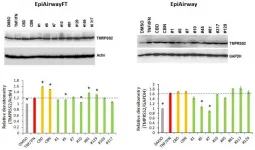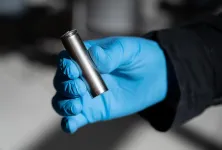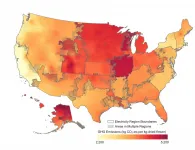(Press-News.org) Here is a link to a free Altmetric Report on this Research Output
Aging-US published "Hyperbaric oxygen therapy increases telomere length and decreases immunosenescence in isolated blood cells: a prospective trial" which reported that the aim of the current study was to evaluate whether hyperbaric oxygen therapy (HBOT) affects telomere length (TL) and senescent cell concentrations in a normal, non-pathological, aging adult population.
Thirty-five healthy independently living adults, aged 64 and older, were enrolled to receive 60 daily HBOT exposures.
Whole blood samples were collected at baseline, at the 30th and 60th session, and 1-2 weeks following the last HBOT session.
Telomeres length of T helper, T cytotoxic, natural killer and B cells increased significantly by over 20% following HBOT.
In this Aging-US study, the most significant change was noticed in B cells which increased at the 30th session, 60th session and post HBOT by 25.68%±40.42 , 29.39%±23.39 and 37.63%±52.73, respectively.
Dr. Amir Hadanny and Dr. Shai Efrati said, "Aging can be characterized by the progressive loss of physiological integrity, resulting in impaired functions and susceptibility for diseases and death."
At the cellular level, there are two key hallmarks of the aging process: shortening of telomere length and cellular senescence.
Shortened TLs can be a direct inherited trait, but several environmental factors have also been associated with shortening TL including stress, lack of physical endurance activity, excess body mass index, smoking, chronic inflammation, vitamins deficiency and oxidative stress.
Cellular senescence is an arrest of the cell cycle which can be caused by telomere shortening, as well as other aging associated stimuli independent of TL such as non-telomeric DNA damage.
The accumulation of senescent cells with aging reflects either an increase in the generation of these cells and/or a decrease in their clearance, which in turn aggravates the damage and contributes to aging.
On the cellular level, it was demonstrated that HBOT can induce the expression of hypoxia induced factor, vascular endothelial growth factor and sirtuin, stem cell proliferation, mitochondrial biogenesis, angiogenesis and neurogenesis.
The Hadanny/Efrati Research Team concluded in their Aging-US Research Output that hyperbaric oxygen therapy is a well-established treatment modality for non-healing wounds, radiation injuries as well as different hypoxic or ischemic events .
In recent years, a growing evidence from preclinical as well as clinical trials demonstrate the efficacy of HBOT for neurological indications including idiopathic sudden sensorineural hearing loss, post stroke and post traumatic brain injury, central sensitization syndrome such as fibromyalgia syndrome and age related cognitive decline and animal models of Alzheimer's disease.
For the first time, the current study aimed to evaluate the physiological effect on the cellular level in aging humans without any functional limiting disease.
INFORMATION:
Sign up for free Altmetric alerts about this article
DOI - https://doi.org/10.18632/aging.202188
Full Text - https://www.aging-us.com/article/202188/text
Correspondence to: Amir Hadanny email: hadannya@shamir.gov.il and Shai Efrati email: efratishai@outlook.com
Keywords: telomere, senescence, aging, hyperbaric oxygen, length
About Aging-US
Launched in 2009, Aging-US publishes papers of general interest and biological significance in all fields of aging research as well as topics beyond traditional gerontology, including, but not limited to, cellular and molecular biology, human age-related diseases, pathology in model organisms, cancer, signal transduction pathways (e.g., p53, sirtuins, and PI-3K/AKT/mTOR among others), and approaches to modulating these signaling pathways.
To learn more about Aging-US, please visit http://www.Aging-US.com or connect with @AgingJrnl
Aging-US is published by Impact Journals, LLC please visit http://www.ImpactJournals.com or connect with @ImpactJrnls
Media Contact
18009220957x105
MEDIA@IMPACTJOURNALS.COM
Aging-US published "In search of preventive strategies: novel high-CBD Cannabis sativa extracts modulate ACE2 expression in COVID-19 gateway tissues" which reported that Cannabis sativa, especially those high in the anti-inflammatory cannabinoid cannabidiol, has been found to alter gene expression and inflammation and harbour anti-cancer and anti-inflammatory properties.
Working under a Health Canada research license, the Aging-US authors developed over 800 new C. sativa cultivars and hypothesized that high-CBD C. sativa extracts may be used to down-regulate ...
Aging-US published "DNA- and telomere-damage does not limit lifespan: evidence from rapamycin" which reported that failure of rapamycin to extend lifespan in DNA repair mutant and telomerase-knockout mice, while extending lifespan in normal mice, indicates that neither DNA damage nor telomere shortening limits normal lifespan or causes normal aging.
Dr. Mikhail V. Blagosklonny said, "As a provocative title has recently announced, 'rapamycin fails to extend lifespan in DNA repair -deficient mice' [1]. The word 'fails' implies bad news. Rapamycin tried but failed. Yet, it is expected that the anti-aging ...
East Hanover, NJ. March 8, 2021. Kessler Foundation researchers have demonstrated changes in the functional connectivity within the 'fatigue network' in response to cognitive fatigue. This finding, the first of its kind, was reported in Scientific Reports on December 14, 2020 in the open access article, "Using functional connectivity changes associated with cognitive fatigue to delineate a fatigue network" (doi: 10.1038//s41598-020-78768-3).
The authors are Glenn Wylie, DPhil, Brian Yao, PhD, Helen M. Genova, PhD, Michele H. Chen, PhD, and John DeLuca, PhD, of Kessler Foundation. All have faculty appointments at Rutgers New Jersey Medical School. Dr. Wylie is also a research scientist at The Department of Veterans' Affairs War-related Injury and Illness ...
A new study of the U.K. and South Africa variants of SARS-CoV-2 predicts that current vaccines and certain monoclonal antibodies may be less effective at neutralizing these variants and that the new variants raise the specter that reinfections could be more likely.
The study was published in Nature on March 8, 2021. A preprint of the study was first posted to BioRxiv on January 26, 2021.
David Ho (Credit: Columbia University Irving Medical Center)
The study's predictions are now being borne out with the first reported results of the Novavax vaccine, says the study's lead author David ...
Hamilton, ON (March 8, 2021) - An analysis of several large studies involving participants from more than 60 countries, spearheaded by researchers from McMaster University, has found that eating oily fish regularly can help prevent cardiovascular disease (CVD) in high-risk individuals, such as those who already have heart disease or stroke.
The critical ingredient is omega-3 fatty acids, which researchers found was associated with a lower risk of major CVD events such as heart attacks and strokes by about a sixth in high-risk people who ate two servings of fish rich in omega-3 each week.
"There is a significant protective benefit of fish consumption in people with cardiovascular disease," said lead co-author Andrew Mente, associate ...
Personalised 3D printed models created from cardiac imaging data, mainly from cardiac CT images have been increasingly used in cardiovascular disease, primarily in the preoperative planning and simulation of complex surgical procedures, as well as medical education. 3D printed models are proved to be highly accurate in replicating normal anatomy and cardiac pathology with reported differences less than 0.5 mm between 3D printed models and original sources images. Further to these applications, a new research direction of utilising 3D printed models is to study the optimal CT scanning protocols in cardiovascular disease with the aim of reducing radiation dose while preserving diagnostic image quality. To achieve ...
A new fabrication technique could allow solid-state automotive lithium-ion batteries to adopt nonflammable ceramic electrolytes using the same production processes as in batteries made with conventional liquid electrolytes.
The melt-infiltration technology developed by materials science researchers at the Georgia Institute of Technology uses electrolyte materials that can be infiltrated into porous yet densely packed, thermally stable electrodes.
The one-step process produces high-density composites based on pressure-less, capillary-driven infiltration of a molten solid electrolyte into porous bodies, including multilayered electrode-separator stacks.
"While the melting point of traditional ...
You've heard of animals that can lose and then regenerate a tail or limb. But scientists reporting in the journal Current Biology on March 8 have now discovered two species of sacoglossan sea slug that can do even better, shedding and then regenerating a whole new body complete with the heart and other internal organs. The researchers also suggest that the slugs may use the photosynthetic ability of chloroplasts they incorporate from the algae in their diet to survive long enough for regeneration.
"We were surprised to see the head moving just after autotomy," said Sayaka Mitoh of Nara ...
It's no secret that the United States' $13 billion cannabis industry is big business. Less obvious to many is the environmental toll this booming business is taking, in the form of greenhouse gas emissions from commercial, mostly indoor production.
A new study by Colorado State University researchers provides the most detailed accounting to date of the industry's carbon footprint, a sum around which there is only limited understanding. What is clear, though, is that consumer demand for cannabis is insatiable and shows no signs of stopping as more states sign on to legalization.
The study, ...
The economic benefits of conserving or restoring natural sites "outweigh" the profit potential of converting them for intensive human use, according to the largest-ever study comparing the value of protecting nature at particular locations with that of exploiting it.
A research team led by the University of Cambridge and the Royal Society for the Protection of Birds (RSPB) analysed dozens of sites - from Kenya to Fiji and China to the UK - across six continents. A previous breakthrough study in 2002 only had information for five sites.
The findings, published in the journal Nature Sustainability, come just weeks after a landmark report by Cambridge Professor Partha Dasgupta called for the value of biodiversity to be placed at the heart of global economics.
For the latest ...





